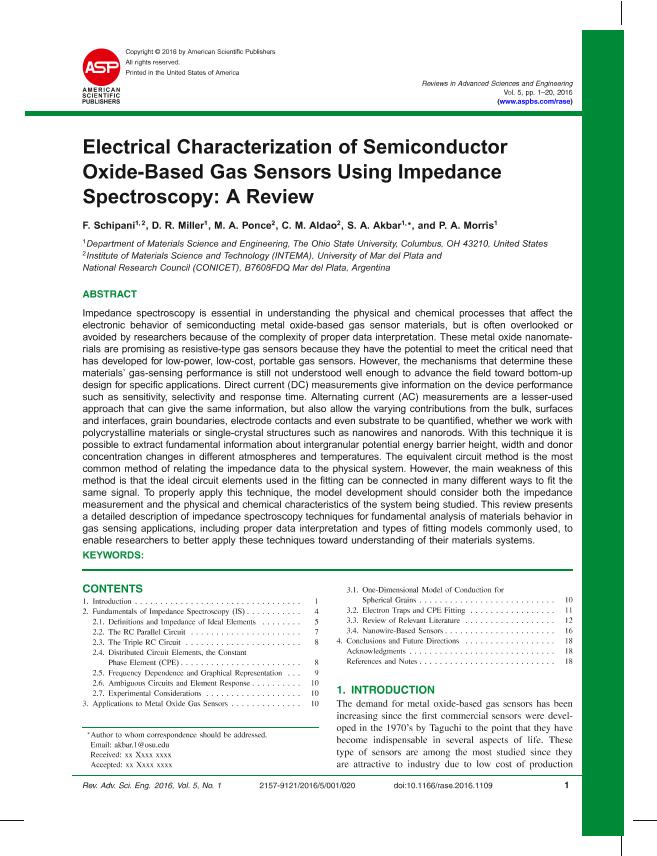Mostrar el registro sencillo del ítem
dc.contributor.author
Schipani, Federico

dc.contributor.author
Miller, D. R.
dc.contributor.author
Ponce, Miguel Adolfo

dc.contributor.author
Aldao, Celso Manuel

dc.contributor.author
Akbar, S. A.
dc.contributor.author
Morris, P. A.
dc.date.available
2018-01-16T14:18:01Z
dc.date.issued
2016-03-01
dc.identifier.citation
Ponce, Miguel Adolfo; Akbar, S. A.; Schipani, Federico; Aldao, Celso Manuel; Morris, P. A.; Miller, D. R.; et al.; Electrical characterization of semiconductor oxide-based gas sensors using impedance spectroscopy: A review; American Scientific Publishers; Reviews in Advanced Sciences and Engineering; 5; 1; 1-3-2016; 86-105
dc.identifier.issn
2157-9121
dc.identifier.uri
http://hdl.handle.net/11336/33388
dc.description.abstract
Impedance spectroscopy is essential in understanding the physical and chemical processes that affect theelectronic behavior of semiconducting metal oxide-based gas sensor materials, but is often overlooked oravoided by researchers because of the complexity of proper data interpretation. These metal oxide nanomaterialsare promising as resistive-type gas sensors because they have the potential to meet the critical need thathas developed for low-power, low-cost, portable gas sensors. However, the mechanisms that determine thesematerials? gas-sensing performance is still not understood well enough to advance the field toward bottom-updesign for specific applications. Direct current (DC) measurements give information on the device performancesuch as sensitivity, selectivity and response time. Alternating current (AC) measurements are a lesser-usedapproach that can give the same information, but also allow the varying contributions from the bulk, surfacesand interfaces, grain boundaries, electrode contacts and even substrate to be quantified, whether we work withpolycrystalline materials or single-crystal structures such as nanowires and nanorods. With this technique it ispossible to extract fundamental information about intergranular potential energy barrier height, width and donorconcentration changes in different atmospheres and temperatures. The equivalent circuit method is the mostcommon method of relating the impedance data to the physical system. However, the main weakness of thismethod is that the ideal circuit elements used in the fitting can be connected in many different ways to fit thesame signal. To properly apply this technique, the model development should consider both the impedancemeasurement and the physical and chemical characteristics of the system being studied. This review presentsa detailed description of impedance spectroscopy techniques for fundamental analysis of materials behavior ingas sensing applications, including proper data interpretation and types of fitting models commonly used, toenable researchers to better apply these techniques toward understanding of their materials systems.
dc.format
application/pdf
dc.language.iso
eng
dc.publisher
American Scientific Publishers

dc.rights
info:eu-repo/semantics/openAccess
dc.rights.uri
https://creativecommons.org/licenses/by-nc-sa/2.5/ar/
dc.subject
Semiconductors
dc.subject
Impedance Spectroscopy
dc.subject
Capacitance
dc.subject
Models
dc.subject
Conduction Mechanisms
dc.subject
Oxide-Based Gas Sensors
dc.subject.classification
Recubrimientos y Películas

dc.subject.classification
Ingeniería de los Materiales

dc.subject.classification
INGENIERÍAS Y TECNOLOGÍAS

dc.title
Electrical characterization of semiconductor oxide-based gas sensors using impedance spectroscopy: A review
dc.type
info:eu-repo/semantics/article
dc.type
info:ar-repo/semantics/artículo
dc.type
info:eu-repo/semantics/publishedVersion
dc.date.updated
2018-01-12T19:25:56Z
dc.journal.volume
5
dc.journal.number
1
dc.journal.pagination
86-105
dc.journal.pais
Estados Unidos

dc.journal.ciudad
California
dc.description.fil
Fil: Schipani, Federico. Consejo Nacional de Investigaciones Científicas y Técnicas. Centro Científico Tecnológico Conicet - Mar del Plata. Instituto de Investigaciones en Ciencia y Tecnología de Materiales. Universidad Nacional de Mar del Plata. Facultad de Ingeniería. Instituto de Investigaciones en Ciencia y Tecnología de Materiales; Argentina
dc.description.fil
Fil: Miller, D. R.. Ohio State University; Estados Unidos
dc.description.fil
Fil: Ponce, Miguel Adolfo. Consejo Nacional de Investigaciones Científicas y Técnicas. Centro Científico Tecnológico Conicet - Mar del Plata. Instituto de Investigaciones en Ciencia y Tecnología de Materiales. Universidad Nacional de Mar del Plata. Facultad de Ingeniería. Instituto de Investigaciones en Ciencia y Tecnología de Materiales; Argentina
dc.description.fil
Fil: Aldao, Celso Manuel. Consejo Nacional de Investigaciones Científicas y Técnicas. Centro Científico Tecnológico Conicet - Mar del Plata. Instituto de Investigaciones en Ciencia y Tecnología de Materiales. Universidad Nacional de Mar del Plata. Facultad de Ingeniería. Instituto de Investigaciones en Ciencia y Tecnología de Materiales; Argentina
dc.description.fil
Fil: Akbar, S. A.. Ohio State University; Estados Unidos
dc.description.fil
Fil: Morris, P. A.. Ohio State University; Estados Unidos
dc.journal.title
Reviews in Advanced Sciences and Engineering
dc.relation.alternativeid
info:eu-repo/semantics/altIdentifier/url/http://www.aspbs.com/rase/contents_rase51.htm
dc.relation.alternativeid
info:eu-repo/semantics/altIdentifier/doi/http://dx.doi.org/10.1166/rase.2016.1109
Archivos asociados
